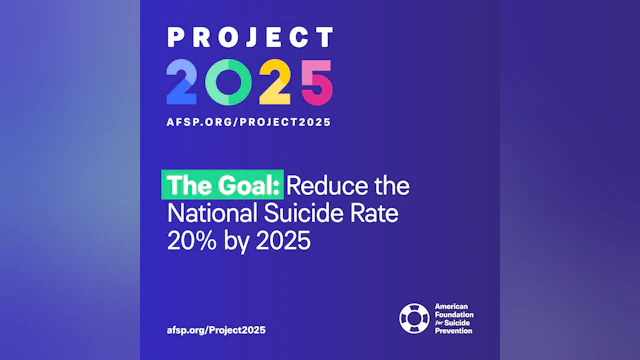Contact: Alexis O’Brien, PR Director, 347-826-3577, [email protected]
Supporting AFSP’s Project 2025 Goal to Reduce the Annual Suicide Rate 20 Percent by 2025
NEW YORK (AUGUST 29, 2016) – As we head into National Suicide Prevention Week (September 5-11), the largest suicide prevention organization in the United States, the American Foundation for Suicide Prevention, launches the next phase of Project 2025. Project 2025 is a high-impact, collaborative initiative developed by AFSP, aimed at the organization’s bold goal of reducing the annual suicide rate 20 percent by 2025. Using a dynamic systems model designed for AFSP by CALIBRE Systems and input from a national advisory council of experts in the field, AFSP has determined three critical areas our country needs to invest in to have the greatest impact for suicide prevention and the potential to save thousands of lives within the next 10 years: (1) firearms and suicide prevention, (2) large healthcare systems, and (3) emergency departments.
“As the tenth leading cause of death in the United States, suicide does not get the attention it deserves. For years there has been a gap between what the research tells us works in preventing suicide and what actually happens in healthcare settings and communities across the country,” said AFSP CEO Robert Gebbia. “This phase of Project 2025 gives us a clear and focused prescription of how to reduce the suicide rate. As a country, we need to invest in what we know works. We know we can’t do this alone. This will require an all-out effort from leaders across all industry sectors and communities nationwide. Together, we will save thousands of lives.”
From the model built for Project 2025, AFSP shares examples of how many lives could be saved at a national level if we scaled up and made strategic investments, and applied the collective resources necessary to support these prevention areas over the next 10 years.
Critical Area # 1 – Firearms and Suicide Prevention = Save 9,500 Lives
At the National level, if 50 percent of all individuals who purchase a Firearm are exposed to suicide prevention education (assuming just 20 percent effectiveness of the education), we can expect an estimated 9,500 lives saved through 2025.
Critical Area # 2 – Large Healthcare Systems = Save 9,200 Lives
If we do a better job of identifying people who are at risk in Large Healthcare Systems (such as during a primary care visit), provide them with a short-term intervention and include better follow-up care, we can expect an estimated 9,200 lives saved through 2025. In the area of large healthcare systems, expanding the use of the Zero Suicide approach also shows promise for reducing suicides among those seen in large healthcare systems. By fully integrating suicide prevention across a healthcare system, patients at risk for suicide would be identified and appropriately cared for without falling through the cracks.
Critical Area # 3 – Emergency Departments = Save 1,100 Lives
If we do a better job of identifying people at risk for suicide (through screening) in Emergency Departments, and providing them with a short-term intervention like Safety Planning and include better follow-up care, we can expect to save an estimated 1,100 lives through 2025.
Based on these findings, AFSP intends to collaborate with other organizations, accrediting bodies and professional associations as well as leaders in other industry sectors, to implement specific strategies for reducing the rate of suicide, and focus its prevention efforts on the kinds of programs, policies and interventions that will save the most lives in the shortest amount of time.
AFSP has begun this work already by funding research studies in these three areas, and forming a partnership with the National Sports Shooting Foundation to build and implement public education resources for firearms retailers, shooting ranges and the firearms-owning community to raise the awareness of suicide prevention and firearms. All 85 AFSP local chapters will have a key role to play based on current programs and policy priorities at the state level.
Project 2025 was funded, in large part, by general funds collected by AFSP volunteers from local walks nationwide. AFSP organizes nearly 400 local community walks to raise money and awareness for suicide prevention annually. It was through these Out of the Darkness walks that AFSP was able to support such a large-scale national initiative. To get involved locally, find a walk happening near you: afsp.org/walks.
More about Project 2025
Launched in October 2015, Project 2025 is a high-impact, collaborative initiative developed by AFSP, aimed at the organization’s bold goal of reducing the annual suicide rate 20 percent by 2025. Using a dynamic systems model approach based on what the evidence tells us about suicide, AFSP has determined a series of actions and critical areas to help us reach our goal. With this approach we reach across all demographic and sociological groups to have the greatest impact for suicide prevention and the potential to save thousands of lives within the next 10 years. If we work collectively to expand the above interventions by key area (Firearms, Emergency Departments, and in Large Healthcare Systems) – cumulatively, we can expect to save nearly 20,000 lives through 2025.
The American Foundation for Suicide Prevention is dedicated to saving lives and bringing hope to those affected by suicide. AFSP creates a culture that’s smart about mental health through education and community programs, develops suicide prevention through research and advocacy, and provides support for those affected by suicide. Led by CEO Robert Gebbia and headquartered in New York, with a Public Policy Office in Washington, D.C. AFSP has local chapters in all 50 states and the District of Columbia with programs and events nationwide. Learn more about AFSP in its latest Annual Report, and join the conversation on suicide prevention by following AFSP on Facebook, Twitter, Instagram, and YouTube.
